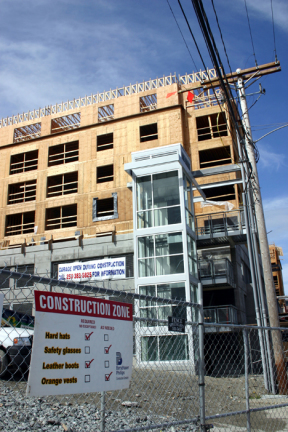Its Thursday evening on the campus of the University of Washington Tacoma, and a dozen prospective freshmen gather in a hallway of the Birmingham Hay and Seed building. Theres free pizza, tours of the campus, and a welcoming committee that includes the chancellor, professors, and students.
This open house is aimed at young people like Meagan Brady-Barnes, a 17-year-old senior at White Pass High School in Randle, Washington. Brady-Barnes, along with her parents, made the 80-mile trek to downtown Tacoma to see what the university has to offer. Though shes been admitted to the UW Seattle campus, Brady-Barnes is looking for a smaller college environment.
I love the campus, says Brady-Barnes after a tour with her parents and a small group of other prospective freshmen. Its very impressive. If she applies to the UW Tacoma and is accepted, shell move downtown — possibly into a new apartment complex under construction just up the hill.
Welcome to a new chapter for Brady-Barnes and UW Tacoma.
In September, the university will admit approximately 150 freshmen, the first time in the 16-year history of the school. Previously, students had to meet core requirements elsewhere (at community colleges, mostly) before transferring to the Tacoma campus. But thats changed, thanks to a long slog by legislators in Olympia, and a bill signed by Gov. Christine Gregoire last year.
For freshmen, its a competitive environment. The school has received 377 applications, according to Dan Garcia, Assistant Chancellor for Student Affairs. Though the application deadline passed March 1, the admissions office still receives applications, which are reviewed on a space-available basis.
Its competitive largely because of what the school has to offer: significant scholarship and financial aid opportunities (administrators say half the students will receive scholarship support); an intimate learning environment (no more than 25 students for each professor); and an urban, lively setting (the university is surrounded by a variety of shops, cafes, and restaurants).
Indeed, as much as these students are eyeing the university, some nearby merchants and unveristy administrators are thinking about the potential impact this new population might have on bottom lines.
I think the main point about having freshmen here is that you have a different kind of student, says Mike Wark, director of public relations at the university. Historically, adds Wark, most of the universitys students were working adults, some with families or homes away from downtown, who stayed on campus for shorter periods of time. These students typically enrolled in courses to finish degrees after a period away from school, pursue graduate graduates, or retrain.
This new crop of students, however, will be younger and more interested in exploring the nearby cafes (such as Metro Coffee, Renaissance, and Cutters Point), shops (Buzzards CDs, Phoenix Rising Snowboards, and Urban Xchange), and restaurants (Taco Del Mar, Subway, and the Old Spaghetti Factory).
Last April, in order to meet demands related to this growth, developers and the university broke ground on a mixed-use project on university-owned land located a block away from the campus: a three-story, university-owned, 309-car parking garage, and a five-story, 129-unit apartment building (owned by developer Lorig and Associates; UW Tacoma leased the air rights) named Court 17.
Though the apartments will be available to everyone, students and faculty will have first priority. Wark says so much residential development downtown has been focused on condominiums. Court 17 will fill a need for apartment housing. We anticipate that a lot of students will be moving into these apartments, he says. This is going to be a well-located apartment in heart of downtown. I think it will help create a vibrant, urban setting. I think well see more people walking around, patronizing local businesses, and just hanging out.
Marty Campbell, president of the Downtown Merchants Group, says business owners in the area are talking a little bit about the economic impact of these new students. But how much of an impact 150 students will have is unclear.
Campbell says long-term growth of the university will be good news for merchants, and this new crop of students will contribute to that goal. For us, its going to be a positive, adds Campbell. A few more people moving about makes the area more of a center, and thats positive for downtown. Were appreciative of the universitys efforts toward growth.
At The Swiss, a popular nearby pub, owners are pleased to see the university expand. The bar will remain 21-and-over, says co-owner Gayl Bertagni, therefore excluding the incoming freshmen. But growing along with the university is exciting, says Gayl Bertagni.
Indeed, a combination of things — incoming freshmen, a new apartment building, long-term growth at the university — could collectively result in a bottom-line benefits for downtown merchants
We know theres going to be a certain amount of growth going forward, says Wark, who estimates the campus will grow by 225 full-time equivalent students per year over the next four years, depending on the legislative funding. Just having more people on campus will create more traffic for local businesses.








